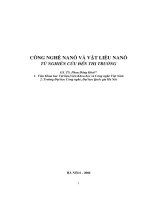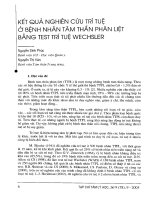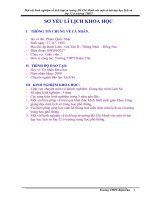2 kinh nghiem vien ket hop tu nghien cuu den ho so benh nhan dr ngo minh hung
Bạn đang xem bản rút gọn của tài liệu. Xem và tải ngay bản đầy đủ của tài liệu tại đây (6.46 MB, 37 trang )
KINH NGHIỆM VỚI VIÊN KẾT HỢP
TỪ PHÂN TÍCH GỘP ĐẾN HỒ SƠ BỆNH NHÂN
Ts Bs Ngô Minh Hùng
Tim mạch Can thiệp – Bệnh Viện Chợ Rẫy
CVRFS AND HEART DISEASE
Framingham
Nguy cơ tim
mạch nền tảng:
•
•
•
•
Cholesterol
Hút thuốc lá
Tăng huyết áp
Đái tháo đường
Chuỗi bệnh lý tim mạch
1. Expert Rev. Cardiovasc. Ther. 2007;5(2):177-193. 2. Am J Cardiol. 1998;82:3Q-12Q. 3. Lancet 2004;364:685-696. 4. NEJM 2004;350:1495-1504. 5.
JAMA 2005;294:2437-2445. 6. Lancet 2005;366:1267-1278 7. Expert Rev. Cardiovasc. Ther. 2004;2(3):431-449
World Health Organization. Integrated management of cardiovascular risk – report of a WHO meeting, Geneva, 9–12 July 2002.
Available at: Accessed: Oct 2009
CVRFS AND HEART DISEASE
11/3/2020
TOTAL CV RISK
(1) No risk estimation models are needed for persons with:
Documented CVD
DM2
Very high levels of individual risk factors
CKD
(2) For all other people, the use of a risk estimation system
such as SCORE is recommended to estimate total CV risk.
4
European Heart Journal (2016) 37, 2999–3058
CVRF: HYPERTENSION
Phân tích gộp 61 nghiên cứu tiền cứu, quan sát
- 1 triệu người lớn
- 12,7 triệu bệnh nhân - năm
Giảm thêm
10% tử vong
do bệnh mạch
vành
Giảm 10
mmHg
HATh trung
bình
Giảm thêm
40% tử vong
do đột quỵ1
Điều trị THA là cần thiết
Lewington S et al. Lancet 2002;360:1903-1913.
STUDIES ON SINGLE PILL COMBINATION (SPC)
◼All 29 studies reported on adherence and/or persistence in patients
taking SPC therapy for hypertension.
756
04 RCTs (14%)
25 Observational Studies (86%)
◼Sample sizes
75 to 79,958 for SPC therapy
645
111
29
4 RCTs 25 Obs
73 to 383,269 for Free Dose Combination Therapy.
Mancia G, et al. J Hypertens 2015; 33:401–411. Mourad JJ, et al. J Hypertens 2017; 35: 1481–1495.
edogoda SV, et al. Cardiol Ther 2017; 6:91–104. Webster R, et al. JAMA 2018; 320:566–579
RCTS ON SINGLE PILL COMBINATION
Mancia G, et al. J Hypertens 2015; 33:401–411. Mourad JJ, et al. J Hypertens 2017; 35: 1481–1495.
edogoda SV, et al. Cardiol Ther 2017; 6:91–104. Webster R, et al. JAMA 2018; 320:566–579
7
OBSERVATIONAL STUDIES ON SPC
Fleig SV, et al. Adv Ther 2018; 35:353–366. Jadhav U, et al. PLoS One 2014; 9:e92955.
Jung HW, et al. Clin Exp Hypertens 2015; 37:482–489. Liakos CI, et al. Am J Cardiovasc Drugs 2017;17:391–398.
COMBINATIONS
CHANGE IN BP AND BP CONTROL
◼Only 14 studies (48%) reported the number of patients
reaching their target BP (<140/90 mmHg), although none
reported the time to achieve BP control.
◼The percentage of patients who achieved target BP ranged
from 25% (after1 month) [1] to 89% (after 4 months) [2].
[1] Mourad JJ, et al. J Hypertens 2017; 35:1481–1495
[2] Vlachopoulos C, et al. Curr Med Res Opin 2016; 32:1605–1610
CHANGE IN BP AND BP CONTROL
◼ 16/29 studies (55%) clearly reported change in BP during the study which
included all four RCTs
◼ 03/29 studies (19%) compared change in BP between SPC vs free-dose
combination regimens [1; 2; 3]
Webster et al. [3] reported a significant difference in BP with SPC vs. free-dose
combination therapy (reduction in SBP –29.3 vs. –20.6 mmHg; P < 0.001),
Whereas, Bramlage et al. [1] reported no significant difference in change in BP
with SPC vs. F-DCR (SBP –9.1 vs. –8.7 mmHg; P = 0.964) and Nedogoda et
al. [2] reported change in BP was similar between T-SPC [per/indapamide
(ind)/amlo] and two-pill therapy (dual SPC per/ ind ỵ amlo; change in SBP –
21.5 vs. –20.0 mmHg).
[1] Bramlage P, et al. J Clin Hypertens (Greenwich) 2018; 20:705–715; [2] Nedogoda SV, et al. Cardiol Ther 2017; 6:91–104
[3] Webster R, et al. JAMA 2018;320:566–579
CARDIOVASCULAR MORBIDITY AND MORTALITY
◼ There were no RCTs that investigated cardiovascular outcomes
◼ Information regarding cardiovascular outcomes with SPC therapy:
Simons et al. [1]: HR of death over 48 months SPC vs TPT was 1.83 [95% CI 1.55–
2.16]. HR for discontinuation with SPC vs TPT was 1.86 (95% CI 1.74–1.99).
Verma et al. [2]: HR of death 3.4 events/100 persons vs. 3.9 events/100 persons; HR
=0.89; 95% CI, 0.81–0.97; P < 0.01) [2].
Tung et al. [3]: HR of MACE b/w SPC vs TPT (HR = 0.83; 95% CI, 0.73–0.94; P <
0.001)
◼ However, for an on-treatment analysis, there was no significant difference between
treatment arms, demonstrating the importance of adherence in the treated population
(HR = 1.06; 95% CI, 0.86–1.31; P = 0.60) [2].
[1] Simons LA, et al. Curr Med Res Opin 2017; 33:1783–1787; [2] Verma AA, et al. PLoS Med 2018; 15:e1002584
[3] Tung YC, et al. J Clin Hypertens (Greenwich) 2015; 17:51–58
ELEVATED LDL-C INCREASES RISK OF CV EVENTS IN
DIFFERENT PATIENT POPULATIONS
4S-Pl
25
Secondary prevention
CHD Events (%)
Primary prevention
20
HPS
ASCOT
4S-Rx
15
Lipid-Pl
CARDS
HPS-Pl
CARE-Pl
CARE-Rx
HPS-Rx
10
5
LIPID-Rx
WOS-Pl
WOS-Rx
CARDS-Pl
ASCOT-Pl
CARDS-Rx
AFCAPS-Pl
ASCOT-Rx
0
1.3
1.8
2.3
AFCAPS-Rx
2.84
3.36
3.87
4.39
4.91
End of Study LDL-C (mmol/L)
5.43
4S=Scandinavian Simvastatin Survival
Study
AFCAPS=Air Force/Texas Coronary
Atherosclerosis Prevention Study
ASCOT=Anglo-Scandinavian Cardiac
Outcomes Trial
CARDS=Collaborative AtoRvastatin
Diabetes Study
CARE=Cholesterol and Recurrent
Events
HPS=Heart Protection Study
LIPID=Long-Term Intervention with
Pravastatin Group in Ischaemic
Disease
WOSCOPS=West of Scotland
Coronary Prevention Study Group
CHD=coronary heart disease; LDL-C=low-density lipoprotein cholesterol;
Rx=drug group; PI=placebo group.
Adapted from Kastelein JJP. Atherosclerosis 1999:143(suppl 1);S17-S21. Heart Protection Study Collaborative Group. Lancet 2002;360:7-22. Sever PS et al. Lancet 2003;361:1149-58.
Colhoun HM et al. Lancet 2004;364:685-96.
CVRF: LDL-C
◼ Meta-analysis CTT (Cholesterol Treatment Trialists) đã chứng minh được mối
liên hệ giữa việc giảm LDL-C một cách hiệu quả và an toàn bằng statin với
giảm kết cục lâm sàng (26 thử nghiệm lâm sàng trên 170,000 bệnh nhân)
Tỉ lệ giảm biến cố TM
tương ứng (%)
Giảm LDL-C, giảm biến cố tim mạch
LDL-C
1mmol/l
Major coronary events
Major vascular events
(39mg/dl)
Biến cố
mạch vành
23%
Reduction in LDL-C (mmol/L)
Baigent C et al. Lancet 2005;366:1267–78
Lancet 2010;376:1670-81
Biến cố tim
mạch
chính
21%
GOOD COMBINATIONS?
◼Hemodynamic drugs: Single Pill for one (CVRF)
◼Hemodynamic and Metabolic drugs: Single Pill for two (CVRFs)
Drug 2:
Cholesterol
Lowering
Drug 2: Antihypertensive
Drug 1: Antihypertensive
Drug 1: Antihypertensive
Hypertension
CVRFs
Potential Benefit of Dual BP and Cholesterol Lowering on
CHD Mortality (per 100,000 Patient-Years)
n=108 879 men
Cholesterol
Lowering
CHD mortality 100,000
Patient-Years
17.7
14.5
BP
Lowering
10.4
11.5
7.4
4.6
5.9
3.8
2.9
≥160
5.0
2.9
≥240
140-159
1
200-239
<200
130-139
<130
SBP=systolic blood pressure.
Adapted from Thomas F et al. Eur Heart J 2002;23:528-35.
Observational Data Show Lipid and BP Interactions
(Data From TNT Trial)
Lipid Tertiles
TNT Endpoint (%)
Primary Endpoint
(Major CVD Events)
CHD Death/
Non-fatal MI
Fatal/Non-fatal Stroke
BP
(mm Hg)
<73
74-94
≥95
mg/dL
mg/dL
mg/dL
≥140
9.3
10.3
12.3
<140
7.1
9.2
11.1
≥140
5.9
7.3
9.5
<140
5.5
6.7
8.7
≥140
3.5
3.4
3.6
<140
1.6
2.7
2.7
MI=myocardial infarction.
Adapted from Kostis J et al. J Clin Hypertens 2008;10:367-76.
ASCOT: A Study in Hypertensive Patients at
Low-to-Moderate CV Risk
Hypertensive patients with ≥3 additional CV risk factors
Randomized
N=19,342
BPLA1
Amlodipine perindopril
doxazosin GITS
LLA2
Eligible for lipid-lowering arm
(TC ≤6.5 mmol/L [≤250 mg/dL]) (n=10,305)
Double-blind randomization
Atenolol bendroflumethiazide-K+
doxazosin GITS
Not eligible for lipid-lowering arm
(TC >6.5 mmol/L [>250 mg/dL])
• 5-Year Planned Follow-up
n=5168
Atorvastatin
10 mg
n=5137
Placebo
• Primary Endpoint: Non-fatal MI
and Fatal CHD
GITS=gastrointestinal therapeutic system; TC=total cholesterol.
Adapted from 1. Dahlöf B et al. Lancet 2005;366:895-906. 2. Sever PS et al. Lancet 2003;361:1149-58.
ASCOT-LLA: Effect of Statin + Antihypertensive
Therapy on LDL-C and BP
▪ There were minimal differences in BP and lipids in each treatment arm
LDL-C (mg/dL)
140
165
130
155
120
Blood Pressure
(mm Hg)
SBP
145
110
135
100
95
DBP
90
85
80
0
Baseline
75
1
2
Years
3 Lipid
Closeout
0
1
2
3
4
Years
Atenolol + atorvastatin
Amlodipine + atorvastatin
Atenolol + placebo
Amlodipine + placebo
DBP=diastolic blood pressure.
Adapted from Sever P et al. Eur Heart J 2006;27:2982-88.
Lipid
Closeout
ASCOT-LLA: 36% Reduction in Non-fatal MI and Fatal CHD
When Atorvastatin Added to BP Treatment1
Originally planned length of trial: 5 Years
Actual length of trial: Median 3.3 years
Proportion of Patients (%)
4
Atorvastatin 10 mg (n=5168)
Placebo (n=5137)
3
Trial stopped
early
P=0.0005
2
1
HR=0.64 (0.50-0.83)
0
Significant
benefits
observed in
90 days2
0.0
0.5
1.0
1.5
2.0
2.5
Years
3.0 3.3
5.0
HR=hazard ratio.
Adapted from 1. Sever PS et al. Lancet 2003;361:1149-58. 2. Sever PS et al. Am J Cardiol 2005;96:39F-44F.
ASCOT 2x2 Analysis: Objectives
◼To evaluate the potential interaction between statins and
different antihypertensive treatments (amlodipine vs
atenolol) on the primary endpoint and total CV events
and procedures
Amlodipine +
Atorvastatin
(n=2584)
Amlodipine +
Placebo
(n=2554)
Adapted from Sever P et al. Eur Heart J 2006;27:2982-8.
Atenolol +
Placebo
(n=2583)
Atenolol +
Atorvastatin
(n=2584)
Adding Atorvastatin to Amlodipine is >3x as Effective
for Reducing CHD Outcomes vs. Adding Atenolol
▪ Observations suggest risk for future CV events was lowered most for
patients in ASCOT-LLA treated with amlodipine + atorvastatin combination
36%
reduction
P=0.005
Antihypertensive + atorvastatin
vs
Antihypertensive + placebo
16%
reduction
53%
reduction
P=NS
P<0.0001
Atenolol + atorvastatin
vs
atenolol
NS=not significant.
Adapted from Sever P et al. Eur Heart J 2006;27:2982-8.
Amlodipine + atorvastatin
vs
amlodipine
ASCOT-LLA and 2x2 Summary: CV Event Reduction
▪ Observations suggest risk for future CV events was lowered most for
patients in ASCOT-LLA treated with amlodipine + atorvastatin combination
Endpoint
ASCOT-LLA1
ASCOT 2x22
Amlodipine
Atenolol
Fatal CHD + non-fatal MI
36%
53%
16%
Total CV events and procedures
21%
27%
15%
Fatal + non-fatal stroke
27%
31%
24%
Adapted from 1. Sever PS et al. Lancet 2003;361:1149-58. 2. Sever P et al. Eur Heart J 2006;27:2982-8.
SINGLE-PILL AMLODIPINE/ATORVASTATIN
(CADUET): STUDY PROGRAM
Caduet®
Coadministered
studies
Single-pill
Studies
AVALON
GEMINI &
GEMINI (AALA)
Adherence
Studies
RESPOND
CAPABLE
CARPE
JEWEL
CUSP
TOGETHER
CRUCIAL
GEMINI: CONCLUSIONS
SINGLE-PILL STUDIES:
GEMINI AND GEMINI-AALA
◼SPC (aml/ator) therapy was an efficacious and safe treatment for
patient with concomitant hypertension and dyslipidemia both with and
without additional CV risk factors or CHD, over 14 weeks of treatment
◼SPC (aml/ator) therapy increased the percentage of patients with
concomitant hypertension and dyslipidemia who achieved
recommended treatment goals for BP* and LDL-C** after 14 weeks of
treatment.
GEMINI: Blank R et al. J Clin Hypertens 2005;7:264-73.
GEMINI-AALA: Erdine S et al. J Hum Hypertens 2009;23:196-210.









